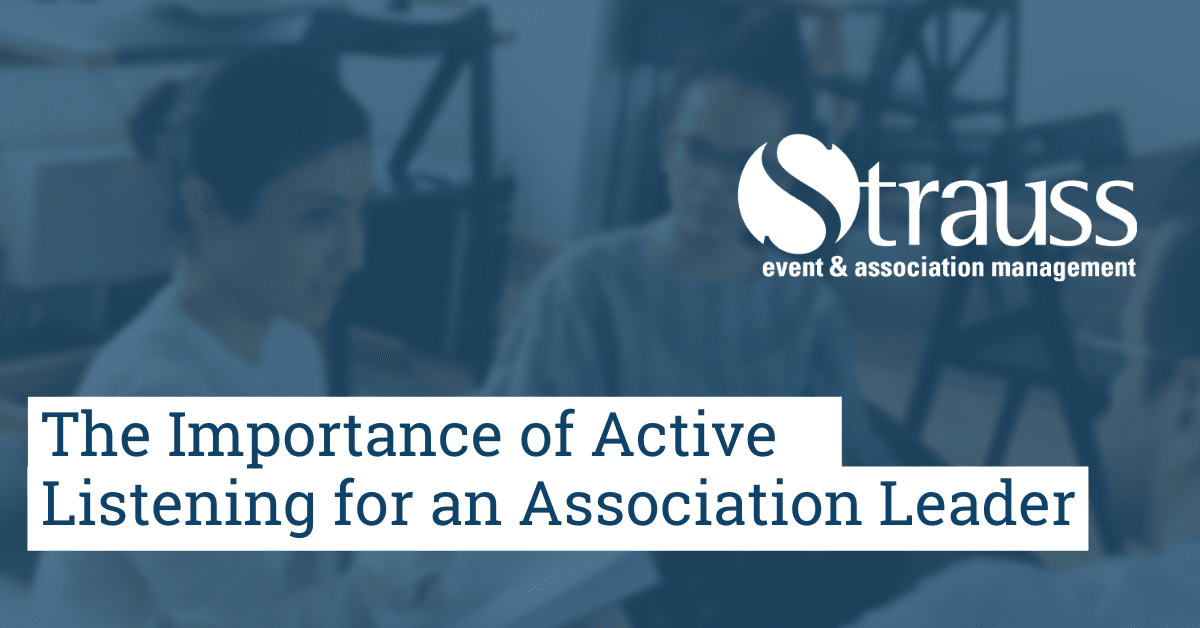Between your “day job”, and your volunteer commitments to your association’s board and/or committees, you are pulled in many different directions throughout your day. While it may seem like you have no time, making the time to listen to members can further develop your leadership role significantly. Moreover, you will gain understanding, consider new ideas and receive valuable feedback.
Unexpected hiccups can cause problems for even the best run associations. A committee member may become frustrated and discuss their frustrations with several other volunteers and the board. It is very important to fully understand their frustration and what they are saying. How will you address this member’s concerns? How can you be sure that you truly heard what they meant? The answer is active listening.
What is Active Listening?
Active listening is a skill that the requires the listener to completely absorb, understand, respond, and remember what someone else is saying. It’s about more than just hearing someone speak. You are fully concentrating on what is being said and giving your full attention while observing important non-verbal cues.
Why is Active Listening important?
Active listening can improve leadership skills and encourage stronger communication between you and association members. Knowing that leaders care about their concerns makes members feel valued in their association. Furthermore, this is important in driving membership engagement. For additional tips, check out my colleague’s article Association Leadership Creates a Top Performing Association.
The 6 Active Listening Skills
- Pay attention – Let the other person think and speak. Don’t cut them off, finish their sentences, or start thinking about your answer before they’ve finished. Pay attention to the speaker’s body language and non-verbal cues as well as your own body language. Make eye contact. Watch for nonverbals cues such as facial expressions and tone of voice. Be focused and in the moment and operate from a place of respect as the listener.
- Withhold judgment – Active listening requires an open mind. It’s important to be open to new ideas, perspectives, and possibilities. Even when you have a strong opinion on an association matter, it’s important to avoid judgement, criticisms, and arguing to sell your point right away.
- Reflect – Don’t assume that you understand the other person correctly or offer unsolicited advice. Periodically paraphrase key points. Reflecting is an active listening technique that indicates that you and the other person are on the same page.
- Clarify – Show interest and ask questions about anything that you find to be confusing or unclear. If you have doubt about what the other person said, say something like, “let me see if I’m clear…” or “are you talking about…?”
- Summarize – Restating key themes during the conversation confirms and strengthens your understanding of the other person’s point of view. It also helps both of you to be clear on mutual association responsibilities and follow-up. Briefly summarize what you have understood and ask the other person to do the same.
- Share – Active listening is first about understanding the other person, then about being seen as a good listener. Once you gain a clearer understanding of the other person’s perspective, you can begin to introduce your ideas, feelings, and suggestions. You might talk about a similar experience you had at an association event or share an idea that was triggered by a comment made previously in a conversation at a board meeting. Once the situation has been talked through, both you and the other person have a good idea of where things stand. From this point, the conversation can shift into problem-solving. What hasn’t been tried? What don’t we know? What new approaches could be taken?
Active Listening Virtually
Active listening can be tough when it’s not possible to attend in-person meetings and board members are calling in from multiple locations. However, it’s still important to show virtual leadership and encourage board members to really listen to what each other have to say. Set the following ground rules:
- Everyone ignores all non-urgent texts or emails during the meeting
- Do not interrupt each other
- Model the six active listening skills outlined above
“You should never be too busy to listen because it’s the ultimate form of respect anyone can give to another human being.” – Leadership First
Being a strong active listener will help you be a strong association leader. Furthermore, fellow association leaders and association members will respect you more and you’ll likely see improvements in your relationships with them as a result. For more important leadership traits, check out my colleague’s article on important Association Leadership Traits.

